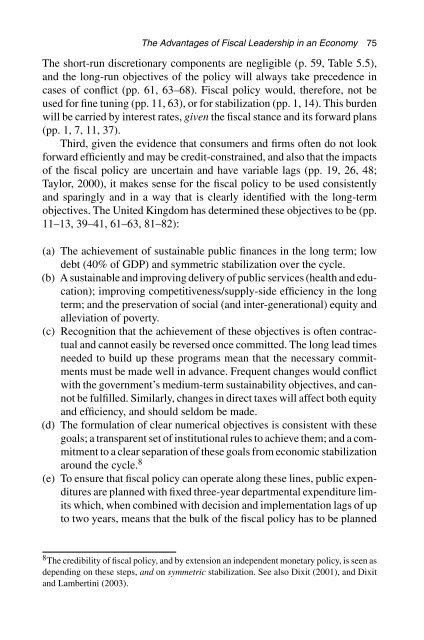Economic Models - Convex Optimization
Economic Models - Convex Optimization
Economic Models - Convex Optimization
You also want an ePaper? Increase the reach of your titles
YUMPU automatically turns print PDFs into web optimized ePapers that Google loves.
The Advantages of Fiscal Leadership in an Economy 75<br />
The short-run discretionary components are negligible (p. 59, Table 5.5),<br />
and the long-run objectives of the policy will always take precedence in<br />
cases of conflict (pp. 61, 63–68). Fiscal policy would, therefore, not be<br />
used for fine tuning (pp. 11, 63), or for stabilization (pp. 1, 14). This burden<br />
will be carried by interest rates, given the fiscal stance and its forward plans<br />
(pp. 1, 7, 11, 37).<br />
Third, given the evidence that consumers and firms often do not look<br />
forward efficiently and may be credit-constrained, and also that the impacts<br />
of the fiscal policy are uncertain and have variable lags (pp. 19, 26, 48;<br />
Taylor, 2000), it makes sense for the fiscal policy to be used consistently<br />
and sparingly and in a way that is clearly identified with the long-term<br />
objectives. The United Kingdom has determined these objectives to be (pp.<br />
11–13, 39–41, 61–63, 81–82):<br />
(a) The achievement of sustainable public finances in the long term; low<br />
debt (40% of GDP) and symmetric stabilization over the cycle.<br />
(b) A sustainable and improving delivery of public services (health and education);<br />
improving competitiveness/supply-side efficiency in the long<br />
term; and the preservation of social (and inter-generational) equity and<br />
alleviation of poverty.<br />
(c) Recognition that the achievement of these objectives is often contractual<br />
and cannot easily be reversed once committed. The long lead times<br />
needed to build up these programs mean that the necessary commitments<br />
must be made well in advance. Frequent changes would conflict<br />
with the government’s medium-term sustainability objectives, and cannot<br />
be fulfilled. Similarly, changes in direct taxes will affect both equity<br />
and efficiency, and should seldom be made.<br />
(d) The formulation of clear numerical objectives is consistent with these<br />
goals; a transparent set of institutional rules to achieve them; and a commitment<br />
to a clear separation of these goals from economic stabilization<br />
around the cycle. 8<br />
(e) To ensure that fiscal policy can operate along these lines, public expenditures<br />
are planned with fixed three-year departmental expenditure limits<br />
which, when combined with decision and implementation lags of up<br />
to two years, means that the bulk of the fiscal policy has to be planned<br />
8 The credibility of fiscal policy, and by extension an independent monetary policy, is seen as<br />
depending on these steps, and on symmetric stabilization. See also Dixit (2001), and Dixit<br />
and Lambertini (2003).
















